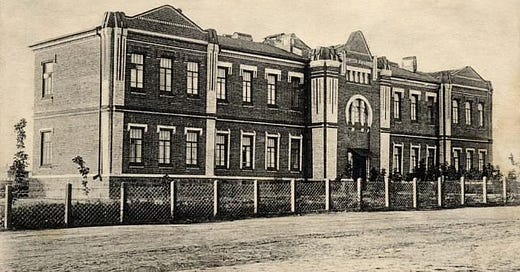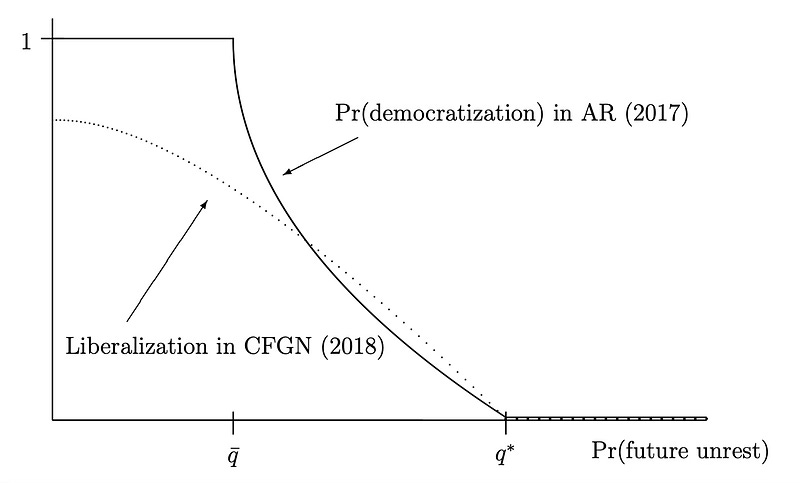A Bit More about Theory in Historical Political Economy
As Volha mentioned in her post on Monday, she, Eugene Finkel, and I are working on something—a review of the field of historical political economy for an audience of political scientists. As part of that process, I have been thinking about the role of theory in HPE. Sean Gailmard’s recent guest post is a useful starting point, as is his more extensive discussion in Jeff’s new Journal of Historical Political Economy. So is Scott Ashworth, Chris Berry, and Ethan Bueno de Mesquita’s excellent Theory and Credibility, which although not explicitly focused on HPE has much to say about the relationship between theory and empirics in social science.
I find it useful to think about these issues with a particular example in mind. Readers will forgive me if I reach for one of my own papers: “Collective Action and Representation in Autocracies: Evidence from Russia’s Great Reforms,” which I wrote with Paul Castañeda Dower, Eugene Finkel, and Steve Nafziger. To my eye, ours was an unusually theoretically motivated exercise for the HPE literature. Focusing on this example can thus help to illustrate the potential and limits of theory in a historical setting.
A bit of background. Our paper addresses a classic question in (historical) political economy: When do autocratic elites transfer power to excluded groups? The predominant view in the literature, expressed in numerous papers and books (including my own), is that regime change and liberalization are more likely when excluded groups find it easier to overcome their collective-action problems. Yet this view is not unanimous. In a series of influential contributions, Daron Acemoglu and James Robinson argue precisely the opposite. In their view, representation (democratization) is a commitment mechanism that is exploited only when the elite is otherwise unable to credibly commit to future redistribution—that is, when the majority poses an infrequent threat of unrest.
Our paper is an attempt to adjudicate this debate. We focus on the creation in (autocratic) Russia in 1864 of the zemstvo, an institution of local self-government with the power to tax and spend. The authority to make these decisions was granted to elected assemblies, with statutory allotments of seats for the gentry, urban property owners, and peasantry that varied greatly across the 365 districts in which zemstva were established. We relate peasant representation in these assemblies to the frequency of peasant unrest in the twelve years prior to creation of the zemstvo. To correct for measurement error in the unrest data and to support a causal interpretation of our results, we employ an instrumental-variables strategy that exploits two important and plausibly exogenous determinants of unrest in the pre-reform period: the historical incidence of serfdom (controlling for distance from Moscow, soil fertility, and the relative size of the rural/peasant population, among other variables) and religious polarization.
Let’s step back. We have an open question, with established theory on both sides of the debate. We have a research setting that provides within-country variation in the outcome and determinant of interest, with a roadmap for credibly identifying the relationship between the former and the latter. This research setting happens to be located in the nineteenth century, under a regime that no longer exists, justifying the qualifier “historical” before “political economy.” This would seem to be a classic example of what Volha on Monday referred to as “us[ing] the past as a setting to investigate general theoretical issues.”
The problem is, much of this theory relates only approximately to the empirical setting. From the perspective of Scott, Chris, and Ethan’s work, we need to worry about whether the target of the theoretical model overlaps with the target of the research design. There is a particular burden on Acemoglu and Robinson’s model, given that it stands alone on one side of the debate we address. The problem is that their outcome (democratization) differs slightly from what we observe in the data (representation): the former is 0/1, whereas the latter is continuous. To expand the overlap, we therefore extend the Acemoglu-Robinson model to allow for a continuous institutional choice by the elite. As we show, the key theoretical implication of the Acemoglu-Robinson generalizes: the more frequently some excluded majority poses a credible threat of unrest, the less representation the elite provides to the majority.
Here, a side note: It turns out that the central proposition in Acemoglu and Robinson’s “Why Did the West Extend the Franchise?” is incorrect. As Daron and Jim discuss in a research note from 2017, when the probability the excluded group poses a credible threat of unrest is neither too low nor too high, the government in fact mixes between democratizing and not democratizing, with positive probability of revolution on the equilibrium path. In a short paper, Paul, Eugene, Steve, and I show that this probability closely tracks the equilibrium level of representation in our extension of the Acemoglu-Robinson model.
So what do we find? Peasants were granted less representation in districts with more frequent unrest in preceding years, as induced by idiosyncratic variation in the historical prevalence of serfdom and religious polarization. Score one for the Acemoglu-Robinson model, score zero for many others (including my own). Still, this is a weak test of the commitment mechanism at the heart of the Acemoglu-Robinson model. In principle, there could be other, unmodeled mechanisms driving the negative relationship between representation and capacity for collective action that we observe in the data. We therefore proceed to “elaborate” on our original analysis, as Scott, Chris, and Ethan put it, drawing out additional theoretical implications that we can take to the data. To wit: As our extension of the Acemoglu-Robinson model shows, capacity for collective action should have a stronger, more positive impact on redistribution where representative institutions have not been granted. We examine this prediction using data on construction of rural schools in post-reform Russia, in districts with and without zemstva. And we find exactly the opposite of what the commitment mechanism in the Acemoglu-Robinson model would suggest.
Where does this leave us? I vaguely remember that Emily once accused us (winkingly) of nihilism, of rejecting all the principles that we thought might govern the relationship between collective action and representation while presenting nothing to replace them. Perhaps in response to that criticism, we conclude the published article with discussion of a few alternative mechanisms that might rationalize our empirical findings. My favorite, I think, is that Russian officials provided less representation to peasants with a history of rebellion in the interests of “demobilization.” Reformers, we speculate, may have feared that providing representation to rebelling peasants would simply fan the flames—say, because peasants now had access to the machinery of the state. But it is true that we fall short of Sean’s aspiration that (H)PE add to the “library of [formalized] mechanisms” with which social scientists interpret historical phenomena. There is only so much that you can say in 12,000 words.
So what have we learned from this exercise? As Sean makes clear, and as John Huber discussed previously, a within-country design that takes causal identification seriously is ultimately a case study. Without theory, we learn little beyond the case itself—to some extent, we must assume what we want to know. That may be fine: as Volha writes, much of HPE endeavors to understand the past for its own sake. I am embedded in a community of scholars who share my idiosyncratic interest in Russian politics and Russian political economy. I am thrilled that they know of our work and what we find. But I think Paul, Eugene, Steve, and I aspired to do more than just that—to contribute to our theoretical understanding of the relationship between collective action and representation in autocracies.
Did we accomplish this goal? At some level, I think our primary theoretical contribution came at the beginning of the project, when we extended the Acemoglu-Robinson model in a direction that better captured our empirical setting. We also teased out a novel theoretical implication of the commitment mechanism at the core of that model—one that I believe was not recognized prior to our work. In principle, both of these could have been accomplished without ever coding up a single district’s worth of data on peasant unrest and representation in zemstvo assemblies. But would we, or anybody else, have thought to do so? I suspect not. This is the sense in which our historical work contributes to theory, even as theory informs our historical work.





